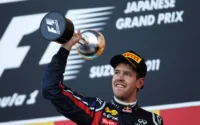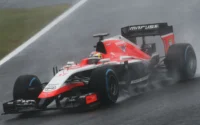Born in Munich, Germany, Jochen Mass started his racing career in 1968 with success, driving an Alfa Romeo Giulia and winning both races he entered. Encouraged by his early wins, he competed in 1969 with an Alfa Romeo 1600 GTA, emerging as a strong contender against Dieter Glemser in the German Touring Car Championship. His performance caught Ford’s attention, leading to an opportunity to test an Escort at Zandvoort.
| Nationality | German |
|---|---|
| Born | Jochen Richard Mass 30 September 1946 Dorfen, Bavaria, Allied-occupied Germany |
Ford signed Mass in 1970 for the European Hillclimb Championship and various saloon car races. That year, he participated in two races and eight hillclimbs, driving a 2.4-litre Capri. In 1971, Mass had his debut in single-seater racing with a Formula Super Vee, winning at the Nurburgring. Soon after, Ford’s Jochen Neerpasch secured a Brabham BT35 for him in Formula 3, prompting a trip to England to collect the car. Mass quickly gained a reputation for his aggressive driving style. He also made his Formula 2 debut in a works March and raced a Ford Escort alongside John Fitzpatrick.
In 1972, Mass clinched the European Touring Car Championship with victories at Spa, Zandvoort, Silverstone, and Jarama, and won the Spa 24 Hours endurance race with Hans-Joachim Stuck in a Ford Capri RS2600. The following year, he joined the Surtees Formula 2 team, achieving wins at Kinnekulle and Hockenheim and finishing second in the championship. He made his F1 Grand Prix debut at Silverstone in 1973 but was involved in a multi-car crash that was started by Jody Scheckter.
Mass competed in a full season of Formula 1 with Surtees in 1974, securing strong finishes early on. However, persistent mechanical issues culminated in a disappointing engine failure at the 1974 German Grand Prix, leading him to leave the team. He joined Yardley McLaren for the season’s last two races and replaced the retiring Denny Hulme in 1975. Known affectionately as ‘Hermann the German’ by the McLaren team, he excelled as a supportive teammate to Fittipaldi, winning the infamous “half points” 1975 Spanish Grand Prix in Barcelona, which was halted early due to a tragic accident involving Rolf Stommelen that resulted in the deaths of four spectators. Mass also performed well at both Paul Ricard and Watkins Glen.
As McLaren’s second driver, Jochen Mass continued in this role for two years after James Hunt joined the team. Mass nearly clinched victory at the 1976 German GP, opting for slick tyres in a strategic move that nearly paid off until Niki Lauda‘s tragic accident led to an early end of the race. He consistently delivered top-six finishes for the team during this period.
In 1977, Mass claimed victories in Formula 2 at Hockenheim and the Nurburgring driving for March. He also started a fruitful sports car racing partnership with Jacky Ickx, securing three wins in the World Championship of Makes with the Martini Racing Porsche team.
Mass joined ATS in the 1978 F1 season, but it proved to be a challenging year, marred by a testing crash at Silverstone that resulted in a broken knee and thigh. In 1979, he moved to Arrows, where, despite driving a less competitive car, he showed strong performances, including a notable third-place run at Monaco until brake issues hit. He remained with Arrows in 1980, achieving his best finish with a second place at the 1980 Spanish Grand Prix, which later lost its championship status.
In 1981, Mass focused on sports cars and Group 5 racing before a brief and disappointing return to Formula One with RAM in 1982. Disenchanted with Formula One, Mass shifted to sports car racing full-time, initially with Rothmans Porsche, then briefly in IMSA, and later with Brun Porsche. In 1987, he joined Sauber, which evolved into the Mercedes-Benz works team.
His notable achievements included winning the 1985 Mugello 1000 km in Italy with a Porsche 962C, the 1987 12 Hours of Sebring with Bobby Rahal, and the prestigious 24 Hours of Le Mans in 1989 with the Sauber-entered Mercedes-Benz.
Transitioning to a management role in the German touring car championship in 1992, Mass continued racing mainly in GT cars. Throughout the 1990s, he was a familiar figure in the Grand Prix paddock, known for his vibrant sense of humour.
In the 2004 Mille Miglia, he piloted the original Mercedes-Benz 300 SLR, famously driven by Stirling Moss in 1955, and auctioned the passenger seat to raise money for charity.
Jochen Mass Formula One World Championship career
| Active years | 1973–1980, 1982 |
|---|---|
| Teams | Surtees, McLaren, ATS, Arrows, March |
| Entries | 114 (105 starts) |
| Championships | 0 |
| Wins | 1 |
| Podiums | 8 |
| Career points | 71 |
| Pole positions | 0 |
| Fastest laps | 2 |
| First entry | 1973 British Grand Prix |
| First win | 1975 Spanish Grand Prix |
| Last win | 1975 Spanish Grand Prix |
| Last entry | 1982 French Grand Prix |
Jochen Mass Teammates
| 15 Teammates | Involvement | First Year | Last Year |
|---|---|---|---|
| Carlos Pace | 8 | 1974 | |
| José Dolhem | 1 | 1974 | |
| Derek Bell | 2 | 1974 | |
| Emerson Fittipaldi | 14 | 1975 | |
| James Hunt | 33 | 1976 | 1977 |
| Gilles Villeneuve | 1 | 1977 | |
| Bruno Giacomelli | 1 | 1977 | |
| Jean-Pierre Jarier | 6 | 1978 | |
| Alberto Colombo | 2 | 1978 | |
| Keke Rosberg | 3 | 1978 | |
| Hans Binder | 1 | 1978 | |
| Riccardo Patrese | 28 | 1979 | 1980 |
| Mike Thackwell | 1 | 1980 | |
| Raul Boesel | 11 | 1982 | |
| Rupert Keegan | 1 | 1982 |
Race Wins
| Win Number | Grand Prix |
|---|---|
| 1 | 1975 Spanish Grand Prix |
Complete Formula One Results
| Year | Entrant | Chassis | Engine | 1 | 2 | 3 | 4 | 5 | 6 | 7 | 8 | 9 | 10 | 11 | 12 | 13 | 14 | 15 | 16 | 17 | WDC | Pts |
|---|---|---|---|---|---|---|---|---|---|---|---|---|---|---|---|---|---|---|---|---|---|---|
| 1973 | Team Surtees | Surtees TS14A | Ford Cosworth DFV 3.0 V8 | ARG | BRA | RSA | ESP | BEL | MON | SWE | FRA | GBR Ret | NED | GER 7 | AUT | ITA | CAN | USA Ret | NC | 0 | ||
| 1974 | Team Surtees | Surtees TS16 | Ford Cosworth DFV 3.0 V8 | ARG Ret | BRA 17 | RSA Ret | ESP Ret | BEL Ret | MON DNS | SWE Ret | NED Ret | FRA Ret | GBR 14 | GER Ret | AUT | ITA | NC | 0 | ||||
| Yardley McLaren | McLaren M23 | Ford Cosworth DFV 3.0 V8 | CAN 16 | USA 7 | ||||||||||||||||||
| 1975 | Marlboro Team Texaco | McLaren M23 | Ford Cosworth DFV 3.0 V8 | ARG 14 | BRA 3 | RSA 6 | ESP 1 ‡ | MON 6 | BEL Ret | SWE Ret | NED Ret | FRA 3 | GBR 7 | GER Ret | AUT 4 ‡ | ITA Ret | USA 3 | 8th | 20 | |||
| 1976 | Marlboro Team McLaren | McLaren M23 | Ford Cosworth DFV 3.0 V8 | BRA 6 | RSA 3 | USW 5 | ESP Ret | BEL 6 | MON 5 | SWE 11 | FRA 15 | GBR Ret | GER 3 | AUT 7 | ITA Ret | CAN 5 | USA 4 | JPN Ret | 9th | 19 | ||
| McLaren M26 | Ford Cosworth DFV 3.0 V8 | NED 9 | ||||||||||||||||||||
| 1977 | Marlboro Team McLaren | McLaren M23 | Ford Cosworth DFV 3.0 V8 | ARG Ret | BRA Ret | RSA 5 | USW Ret | ESP 4 | MON 4 | BEL Ret | SWE 2 | FRA 9 | 6th | 25 | ||||||||
| McLaren M26 | Ford Cosworth DFV 3.0 V8 | GBR 4 | GER Ret | AUT 6 | NED Ret | ITA 4 | USA Ret | CAN 3 | JPN Ret | |||||||||||||
| 1978 | ATS Racing | ATS HS1 | Ford Cosworth DFV 3.0 V8 | ARG 11 | BRA 7 | RSA Ret | USW Ret | MON DNQ | BEL 11 | ESP 9 | SWE 13 | FRA 13 | GBR NC | GER Ret | AUT DNQ | NED DNQ | ITA | USA | CAN | NC | 0 | |
| 1979 | Warsteiner Arrows | Arrows A1 | Ford Cosworth DFV 3.0 V8 | ARG 8 | BRA 7 | RSA 12 | USW 9 | ESP 8 | BEL Ret | MON 6 | 18th | 3 | ||||||||||
| Arrows A2 | Ford Cosworth DFV 3.0 V8 | FRA 15 | GBR Ret | GER 6 | AUT Ret | NED 6 | ITA Ret | CAN DNQ | USA DNQ | |||||||||||||
| 1980 | Warsteiner Arrows | Arrows A3 | Ford Cosworth DFV 3.0 V8 | ARG Ret | BRA 10 | RSA 6 | USW 7 | BEL Ret | MON 4 | FRA 10 | GBR 13 | GER 8 | AUT DNQ | NED DNS | ITA | CAN 11 | USA Ret | 17th | 4 | |||
| 1982 | March Grand Prix | March 821 | Ford Cosworth DFV 3.0 V8 | RSA 12 | BRA 8 | USW 8 | SMR | BEL Ret | MON DNQ | DET 7 | CAN 11 | NED Ret | GBR 10 | FRA Ret | GER | AUT | SUI | ITA | CPL | NC | 0 |
Sources: Wikipedia.com and historicracing.com


